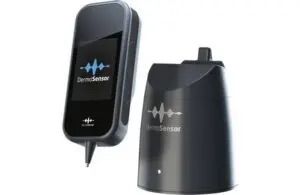- Case-Based Roundtable
- General Dermatology
- Eczema
- Chronic Hand Eczema
- Alopecia
- Aesthetics
- Vitiligo
- COVID-19
- Actinic Keratosis
- Precision Medicine and Biologics
- Rare Disease
- Wound Care
- Rosacea
- Psoriasis
- Psoriatic Arthritis
- Atopic Dermatitis
- Melasma
- NP and PA
- Skin Cancer
- Hidradenitis Suppurativa
- Drug Watch
- Pigmentary Disorders
- Acne
- Pediatric Dermatology
- Practice Management
- Prurigo Nodularis
- Buy-and-Bill
Article
Skin Cancer Detection Device Backed by Studies
Author(s):
DermaSensor’s handheld device is awaiting FDA review.
A new device with skin cancer-detecting capabilities may be on the horizon following positive clinical study results.
Courtesy of DermaSensor

DermaSensor Inc., a medical device company that produces devices equipped to analyze suspicious and potentially cancerous lesions, announced the news in a recent press release1 and in a pooled analysis presentation at the American Academy of Dermatology (AAD) Meeting in New Orleans, LA.
The device, a non-invasive, handheld tool, uses a combination of algorithms and optical spectroscopy technology to assess potentially cancerous skin lesions and evaluate them for cancer in as quickly as seconds.
“DermaSensor’s technology will help primary care physicians detect cancerous skin lesions and refer those patients appropriately to a dermatologist,” said Jane Grant-Kels, MD, in the press release. Grant-Kels is also listed as an author on the AAD publication of the referenced studies.
"Prompt referral from a PCP to a dermatologist can help minimize patient mortality, morbidity and results in the saving of health care dollars,” she said.
The DermaSensor device is intended to serve as a non-objective tool and provide point-of-care assessment assistance for the 200,000 primary care physicians in the US who can detect and refer suspicious skin lesions.
The clinical studies, known as DERM ASSESS III and DERM-SUCCESS, included more than 2000 lesion biopsies across 32 dermatologic study centers. DermaSensor’s device was able to successfully detect 94% of the study’s high-risk lesions. Additionally, it also had a specificity of 23% for low-risk lesions.
In the DERM-ASSESS III study, 10 dermatologic study sites reported the device had a 96% sensitivity for melanoma detection and a 91% sensitivity for high-risk melanocytic lesions.
There were no reported safety concerns related to the device indicated in the studies.
Currently, the DermaSensor device is available for sale in Australia. The device is also awaiting US Food and Drug Administration (FDA) review and has been granted an FDA Breakthrough Device designation.
Reference
- Dermasensor unveils study results demonstrating ability to detect skin cancer with device granted FDA Breakthrough designation. Business Wire. https://www.businesswire.com/news/home/20230317005006/en/DermaSensor-Unveils-Study-Results-Demonstrating-Ability-to-Detect-Skin-Cancer-With-Device-Granted-FDA-Breakthrough-Designation. Published March 17, 2023. Accessed March 22, 2023.
Newsletter
Like what you’re reading? Subscribe to Dermatology Times for weekly updates on therapies, innovations, and real-world practice tips.





